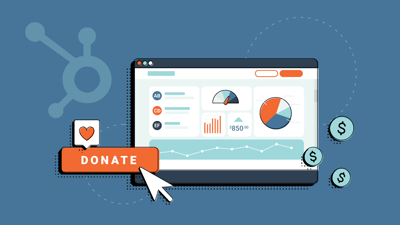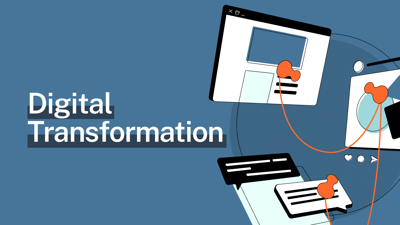How HubSpot-Salesforce Integration Enhances Your Nonprofit’s Operation

Most have little doubt that, to thrive and grow, nonprofits must embrace the right technology.
There’s simply no other way to engage today’s stakeholders on their own terms, be it with the right communications channels, browsers, payment options, mobile platforms, and the like.
And while the digital choices for your “tech stack” are many, we find one particular combination to be a consistent winner.
Teaming Salesforce’s customer relationship management system (CRM) with the HubSpot Marketing Hub creates a powerful fundraising tool for nonprofits of any size.
Let’s talk about Salesforce CRM for nonprofits
A nonprofit CRM is an absolute must for managing constituents and fundraising efforts.
Its ability to collect, store, track, and present data enables you to drive growth by understanding and nurturing stakeholder relationships throughout their lifecycle.
Along with its 10 free licenses, the Salesforce CRM does all that while offering lots of out-of-the-box
- Custom rollups: Consolidating data from lower to upper levels for review and analysis. For example, you can roll up each monthly donor’s contributions into their own subtotal for a specific timeframe, display all subtotals from highest to lowest, then aggregate them into one total.
- Household modeling: Associating all contacts within one household with a primary contact (or account). This hierarchical structure allows you to communicate with the entire household or as segmented individual contacts. Plus, you can analyze collectively or individually.
- Soft credits: Acknowledging the individual or group that prompted a gift. Let’s say a board member encouraged their neighbor to give. While the neighbor would get the hard credit, Salesforce CRM also tracks your board member with a soft credit.
As a note, we rarely recommend the Salesforce Marketing Cloud to nonprofits. Its steep learning curve, need for a highly skilled team, and overall costs make it a likely no-no.
And a bit about the HubSpot Marketing Hub
This is a powerful marketing automation platform, enabling you to easily and immediately engage constituents across multiple channels (email, text, social, and web).
Efficiently and effectively, you can nurture new leads, send email appeals, and deliver specific content based on a donor’s behavior.
And it comes with a 40 percent discount for nonprofits!
Perhaps best of all, the HubSpot Marketing Hub is a seamless fit with Salesforce CRM. This HubSpot-Salesforce integration is powerful, tested, and easily maintained.
But why a HubSpot-Salesforce integration at all? Why not one or the other?
Like most things in life, there are good and not-so-good aspects of each system.
For example, while quite a robust (and free) CRM, extensive customization is likely needed to access Salesforce's marketing automation features. Salesforce is also more complex to operate and typically saddles users with a notable learning curve.
On the other hand, while HubSpot is a superior marketing automation platform, its use as a CRM can be limiting and burdensome. For instance, it can only do basic rollups, and coercing its Operations Hub into creating various custom reports is challenging.
As such, combining Salesforce CRM with the HubSpot marketing platform is a true win-win. Once they’re integrated, you can operate it all through the HubSpot portal.
So now that they’re talking to each other, what should they say?
Data and objects nonprofits should sync between HubSpot and Salesforce
Certainly, contact records with email addresses should be synced. You can merge duplicate contacts and select a primary email address within Salesforce, then sync that over to a HubSpot contact record.
You can identify and sync donors, volunteers, fundraisers, advocates, and other stakeholders, ensuring they’re included or omitted from desired communications.
You can do Salesforce rollups to identify donors meeting certain criteria (like LYBUNTS), and then—via synced data—reengage them with a custom journey through HubSpot.
Plus, you can sync Salesforce opportunities to HubSpot deals for a one-to-one relationship.
Opportunity and deal records contain essential information about a potential give, such as name, amount, stage, probability of giving, and related contacts or accounts.
Syncing these two items ensures that the revenue data from finalized transactions flows back to HubSpot. This closed-loop reporting allows you to connect marketing efforts with actual fundraising outcomes—basically, your ROI. Talk about invaluable!
In fact, one of HubSpot’s main selling points is its revenue attribution reporting. By tracking all interactions along a donor’s journey, HubSpot can determine which marketing activities contributed the most to a conversion. Talk about invaluable even more!
And some things nonprofits shouldn’t sync
Like they say, “Just because you can doesn’t mean you should.”
For numerous reasons, we recommend having a strong, compelling purpose for syncing data and objects within the HubSpot-Salesforce integration.
For one thing, too many syncs can increase system complexity, requiring more of your team’s time, resources, and expertise.
And syncing a high volume of objects can impact the performance and speed of the integration.
Data conflicts, synchronization errors, API call limits, upgrade difficulties, user confusion, and inefficiencies—these are all potential outcomes of over-syncing.
The solution? Just reach out to us to help you identify what should or shouldn’t be synced for your nonprofit.
How reliable is the Hubspot-Salesforce integration?
Very!
HubSpot is a managed package, meaning it comes with all of the components necessary for a smooth, dependable integration with Salesforce CRM.
This combo’s use by thousands of organizations quickly brings any bugs into sharp relief, the fixes for which are included in regularly scheduled updates.
Getting started with your HubSpot-Salesforce integration
HubSpot recommends installing its basic integration. However, in our experience, each nonprofit has unique requirements that beg a more customized setup.
We realize tailoring this integration can be a bit tricky, so we’re here to help! We know the ins and outs of both platforms and can ensure your specific data needs are addressed.
Once done, your marketing team can spend its time just in HubSpot, which we’re confident they’ll find easy to use.
It’s almost as easy as choosing CauseMic as your integration specialist! Just take a moment right now to schedule a FREE Q&A session with one of our experts.




